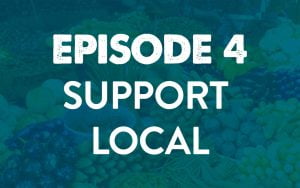In this episode
In this episode we’re all about following the seasons. If we truly want to make a difference this is one area we need to improve on – eating food when it’s at it freshest is fundamental, the less we rely on out of season imports the more we can grow and achieve locally. This is at the heart of food sustainability.
Mick is traveling to Cork to speak with Regina Sexton, food writer and researcher about the history of food here in Ireland and how we once managed to follow the seasons pre famine and make the best use of food during the hungry gap; before taking a trip to Dublin to meet lecturer Dr. Máirtín Mac Con Ionmaire who was awarded Ireland’s first PhD in food history.
Next we’re heading to the world-renowned cookery school of Ballymaloe to chat to chef and food lecturer Rory O’Connell about the importance of eating seasonally when it comes to chefs, their food and cooking.
We return to Waterford to GROW HQ where according to the head chef JB Dubois if it’s not in season and available fresh in the HQ gardens ….. it’s not on the menu. Mick and JB sit down to enjoy a really seasonal delicious meal.
Next on our journey we look at the economics of seasonality with economist and Waterford native Jim Power and we also look at the impact marketing has on people’s perception on seasonality with TUD Lecturer Damian O’Reilly.
To finish the episode Mick heads to Kerry to talk to Lisa Fingleton about a very interesting challenge based around seasonal and local food called the 30-day food challenge, where Lisa can only eat ingredients that come from Ireland.
Stories:
- “The History of the Seasons” – Regina Sexton & Máirtín Mac Con Ionmaire; Cork & Dublin
- “Influencing the Seasons” – Chef, Rory O’Connell, Ballymaloe, Co Cork
- “Real Seasonal Menu” – JB Dubois, Head Chef at GROW HQ, Waterford
- “The Economics of Seasonality” – Jim Power, Dublin City
- “The Marketing of Seasons” – Damian O’Reilly, Dublin City
- “The 30 Day Food Challenge” – Lisa Fingleton, Co. Kerry

Introduction
So many claims about seasonality appear on menus and in the supermarkets that you could be forgiven for thinking anything might be in season at almost any time of year, but the truth is it’s probably not.
The more we understand the seasons and what we can grow in season the better it is for the planet and growing your own food is one way to plug you into the season’s rhythms for real.
The seasons take on a new level of importance when you’re growing something as tiny and unpromising looking as seeds – to turn these little things into towering plants we can eat, we need the seasons on our side.
As they continue to become more unpredictable, these optimistic little seeds will have to navigate later frosts, heavier rains and longer dry spells on their increasingly precarious journey.
So now more than ever it’s important we follow and understand the food seasons. Generally speaking the growing seasons are:
- Spring – seed sowing and transplanting seedlings in to the soil
- Summer – first crops harvesting
- Autumn – a time of plenty
- Winter – a pause for the soil to rest and lean in to the stores of food from autumn

The Problem
- Seasonal food is produce that is purchased and consumed around the time that it is harvested.
- Seasonal food is fresher, tastier and more nutritious – this is because crops picked at their peak of ripeness are also better tasting and full of flavour. The longer the journey and time from plot to plate the less tasty and nutritious the food
- Seasonal food is generally local food. Local food supports the local economy.
- As the weather changes across the globe so does the fresh produce that is available
- Eating seasonally reduces the demand for out of season imported produce, reduces air miles and carbon emissions

Did You Know?

Season and Diet
Producing and eating food according to the basic principles of the natural world is not just an environmental argument. As human beings, we are intrinsically linked to the seasonal rhythm of wherever we live, leading to different dietary needs and desires through the year.
Do you ever really hanker after a salad on a cold winter day? Why does your body crave leafy greens in the spring? If seasonal eating is what your body wants and needs, what does it mean that we have as a society settled in to a diet that stays the same all year round?
Following the seasons demands we put more thought into our food and develop many forgotten kitchen skills. While these skills have been making a comeback among millennials, they were routine among all walks of life throughout Irish history.
Think about the current trend for sauerkraut, kimchi and other fermented foods – though we now see these foods as having specific gut health benefits, these were traditionally preservation methods to deal with gluts of food.

Did You Know?

Practical Steps you can take
- Get curious about when the things you like to eat are in season in Ireland, or whether they can be grown in Ireland at all? Having an understanding of what’s in season, can be the best weapon for us as consumers of food.
- Experiment – try eating the same food in season and out of season. For example taste a tomato from Ireland during the summer and try an imported one during th winter – what do you notice about the taste of each? Do they taste different?
- Would you consider the 30 Day Local Food challenge, eating only food produced on the island of Ireland for a month? If you do it, what ingredients surprised you? Chocolate, tea, coffee etc?
- Grow food yourself – the best way to understand seasonality is to grow food yourself. One of the biggest components of ‘food empathy’ is the knowledge that you acquire about seasonality.
- Buy local and seasonal food – supermarkets and growers have extended the seasons on so many products and imports are available year-round but what’s key to all of this is if its local, fresh and available then it’s in season.

































